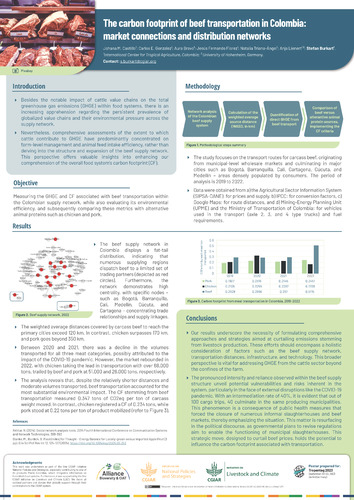The carbon footprint of beef transportation in Colombia: Market connections and distribution networks
Livestock food systems largely contribute to the overall food systems’ greenhouse gas (GHG) emissions and are thus put at the centre of global policy and research agendas on mitigation and adaptation. An additional growing concern on the prevalence of globalised animal product value chains and the specialisation of agricultural markets and their environmental pressures over supply networks further adds to this debate. However, detailed quantification of the livestock contribution intensity to the emissions has focused mostly on the farm and the performance of animals’ feed intake, rather than on the composition and extension of the beef supply network, a perspective that contributes to further our understanding of the food system’s carbon footprint. This research thus used the calculation of food miles to explore the functioning of the Colombian beef market and the emissions entailed in the mobilisation of live animals and processed products in central trade nodes between 2019-2022. The results were compared with emissions derived from the transportation of alternative proteins from animal (chicken, pork, eggs, and milk) and non-animal sources (dry grains). The analysis of bovine products indicates that beef transport was responsible for the highest environmental load, generating on average 25.000 tons CO2eq, in contrast to alternative proteins, where chicken meat is the biggest culprit (40.000 tons CO2eq). However, chicken’s growing demand has increased the quantities mobilised compared to beef, reflecting a greater efficiency of the chicken supply network per volume mobilised. The relational pattern observed in Colombia’s regions pointed out Cali as the leading city in the reception and redistribution of live animals and beef. A strong interaction with neighbouring municipalities in the southwest and the Colombian Amazon configures Cali as a highly central node that, in consequence, concentrates significant pollution. These findings reveal the need to develop comprehensive approaches and strategies to reduce livestock production emissions, acknowledging the vital role that the beef supply network, transportation distances, infrastructure, and technologies play in cattle-derived emissions.

